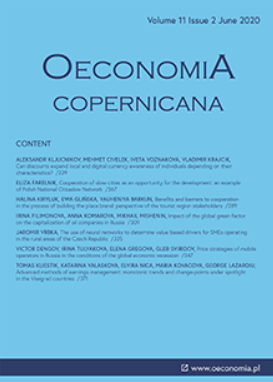Macroeconomic stability and the level of competitiveness in EU member states: a comparative dynamic approach
Macroeconomic stability and the level of competitiveness in EU member states: a comparative dynamic approach
Author(s): Elżbieta Roszko-Wójtowicz, Maria Magdalena GrzelakSubject(s): National Economy, Supranational / Global Economy, Economic policy, Comparative politics, Economic development, EU-Approach / EU-Accession / EU-Development
Published by: Instytut Badań Gospodarczych
Keywords: macroecnomic stabilisation pentagon; competitiveness; competitive position; competitive capacity; Hellwig's method; linear ordering; European Union;
Summary/Abstract: Research background: The choice of the issue of international competitiveness of economies as the research problem addressed in this paper has been mainly dictated by the changes observed in the nature of the development of EU economies and the need to assess the competitiveness of the Polish economy. It is time to evaluate and learn from the largest enlargement in the history of the EU which took place in May 2004. An assessment of changes in the state of EU economies, including the Polish economy, is in the centre of research interest of many scientists. National competitiveness is the subject of a great deal of research and economic studies. Integration and globalisation processes in the world economy are the main reasons for the popularity of this topic. The efficient use of sources and factors determining the competitiveness of economies, sectors and enterprises is associated with prosperity over the long term. One of the methods based on the observation of selected basic indicators of economic competitiveness is the method of analysis called the macroeconomic stabilisation pentagon. The method illustrates the extent to which the government achieves five macroeconomic objectives. It is very difficult, if not impossible, to meet all these objectives at the same time. The difficulty of meeting all these goals concurrently is due to the fact that they are more or less competitive rather than complementary. The proposed assessment of competitiveness based on the developed model of macroeconomic stabilisation pentagon is a unique approach in terms of discussion of country’s competitiveness. This approach significantly distinguishes the current study in comparison with standard international reports on competitiveness such as the Global Competitiveness Index or the EU Regional Competitiveness Index. Purpose of the article: The main aim of the paper is to assess the competitiveness of EU economies in the years 2005–2018, based on a selected set of diagnostic variables referring to the concept of macroeconomic stabilisation pentagon. The paper also formulates a detailed list of four research hypotheses. Methods: In order to characterise the competitiveness of the European Union economies, including the EU–15 and EU–13 groups, as well as the Visegrad group, six diagnostic variables affecting the economic situation of individual EU countries were analysed. The variables for analysis were chosen so as to reliably describe the competitive position of a given country, at the same time referring in a substantive sense to the concept of macroeconomic stabilisation pentagon. The linear ordering of objects was made using the reference Hellwig method. The selected method enabled the development of competitiveness rankings of EU Member States in the years 2005, 2009, and 2018. Findings & Value added: The comparative analysis of the main macroeconomic indicators conducted in the paper forms the basis for assessing the current state of the EU economy in relation to other countries. In the paper, the authors depart from the standard elaboration of ‛magic pentagon.’ Instead, they apply the variables used in the macroeconomic stabilisation pentagon analysis to develop competitiveness rankings of EU Member States.
Journal: Oeconomia Copernicana
- Issue Year: 11/2020
- Issue No: 4
- Page Range: 657-688
- Page Count: 32
- Language: English

